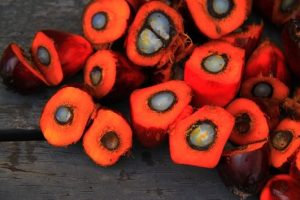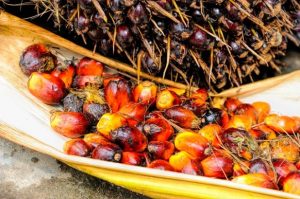At the end of 2016 Italians experienced quite a surprise when, virtually overnight, many of the products in their supermarkets were replaced. Since that happened, they have found the words “palm oil free” emblazoned on the packaging of pizzas, chocolate, biscuits and grissini. Italy has reacted to the long and drawn-out debate on the pros and cons of palm oil – and sided with the critics [1].
Germany, in its own specific way, has also taken a stand. Since December 2014 it has been compulsory in Germany to declare “oils and fats of plant origin” in all lists of ingredients [2]. Prior to this, it was permitted to use the generic term of “vegetable fats” on packaging, but since the introduction of the new regulation, manufacturers have had to state the exact kind of oil used such as rapeseed oil, olive oil or even palm oil. Only now are attentive customers becoming aware of how much palm oil is contained in our food: every year, Germans consume 586,252 tonnes in the form of margarines, baked goods, and chocolate, spreads which contain cacao, ice cream, pizzas and other ready-made products [3].
Health
But why exactly has the oil of Elaeis guineensis (oil palm) recently fallen into disrepute? 
A look at the constituents shows that the oil from the reddish flesh of palm fruits contains some 50 percent saturated fatty acids. Palm kernel oil, which is obtained from the kernel of oil palms, contains up to 80% saturated fatty acids. From a nutritional perspective this is not beneficial as the human organism relies on unsaturated fatty acids such as omega-3-fats. A high intake of saturated fatty acids, in contrast, is the cause of raised cholesterol levels, for example, and is associated with cardiovascular diseases. Far more media attention has, however, been focused on two other constituents of palm oil – glycidyl fatty acid esters (GE) and 3-monochloro-1,2-propanediol (3-MCPD) as well as its fatty acid esters. These compounds occur when vegetable oils are heated over 200 degrees. This happens, for example, when oils are refined (purified). Glycidol in particular – degradation product of GE – is considered to have a genotoxic (mutagenic) and carcinogenic (cancer causing) effect. As stated, this substance occurs when vegetable oils are heated above 200 degrees. And in palm oil the concentrations, at some 2.9 mg/kg, are particularly high (compared to rapeseed oil at < 0.1 mg/kg and olive oil at some 0.3 mg/kg). Free 3-MCPD were also classified as “possibly carcinogenic to humans” by the International Agency for Research on Cancer (IARC) of the WHO in 2011.
Challenge for the environment and society
Despite these health-related aspects, palm oil is becoming an increasingly popular raw material. In addition to the food industry, manufacturers of cosmetic products, washing and cleaning products and also the bioenergy sector are using this inexpensive oil. A significant advantage of the oil palm is a comparatively high yield for the amount of space required. The main producers of the oil are Malaysia and Indonesia. Currently they are responsible for the majority of the 60 million tonnes of palm oil and palm kernel oil produced globally. In Malaysia in particular this has led, however, to an enormous level of CO2 emissions – caused by deforestation of large areas of the rain forest, water drainage and burning of peat soils. Estimates suggest 33 tonnes of CO2-emissions are produced for every tonne of palm oil. In Indonesia as well, cultivation of massive palm oil plantations is causing considerable problems. On account of growing levels of production, Indonesia is meanwhile one of the countries with the most rapidly degrading virgin forest. Deforestation also damages the habitats of many animals threatened by extinction such as orang-utans, Wallace’s Hawk Eagle or the Sumatran tiger. Social problems such as the displacement of indigenous populations, child labour, poor working conditions, wage dumping, a lack of employee rights, etc. are also promoted by the massive palm oil plantations [7, 3].
Good oil? Bad oil?
Nonetheless, palm oil cannot be classified as harmful per se.
The same applies in this case as it does with virtually every issue: handling our raw materials sensibly is crucial. The environmental protection organisation, Greenpeace, launched the “Palm Oil Innovations Group (POIG)” for this purpose in 2013. Its task is to prevent deforestation, land theft and the deprivation of rights of local populations which often accompany palm oil production. Other initiatives, such as the (Forum Nachhaltiges Palmöl (FONAP – ‘forum for sustainable palm oil’), campaign for an improvement in palm oil production. It is positive that an increasing number of companies are turning to such a form of certified palm oil and improving conditions for local populations and the environment step by step. Individuals can use their power as consumers in this case by making sure they only buy certified palm oil when shopping [8, 9].
So what are the alternatives? The replacement of palm oil with other tropical vegetable oils such as coconut or soya oils would only shift the problem, or indeed make it worse, as these types of plants require significantly more space for cultivation of the same yield. In Germany, locally-produced oils such as sunflower or rapeseed oils have the potential to be good alternatives to palm oil. If produced sustainably, these oils can have a positive influence on health as well as on the environment [3].
It remains to be said, however, that palm oil also contains good constituents: the unrefined oil (so-called “red palm oil”) contains, for example, plenty of vitamin E and carotenoids. The majority of these antioxidants are lost, however, during the refining process. Thanks to its high proportion of unsaturated fats, palm oil is also naturally solid so it does not have to be industrially hydrogenated (hardened) for use as margarine and similar products. No trans-fatty acids, which are harmful to health, therefore develop [10]. Through targeted selection of the raw product and optimal production conditions, critical substances which can develop during refining of palm oil can at least be minimised. Many food manufacturers have taken the debates of recent years very seriously. Thus, the GE content in palm oils was reduced by half between 2010 and 2015 according to the European Health Safety Authority (EFSA). The EFSA classifies “the exposure to GE of babies consuming solely infant formula” as “a particular concern”, “as this is up to ten times what would be considered of low concern for public health” [11].
Practical tip
Good processing and careful manufacture of products are decisive. Poorly refined sunflower oil potentially contains more carcinogenic substances than well refined palm oil. Therefore, when shopping try as far as possible to buy good oils from sustainable agriculture, ideally from regional companies. Limiting consumption of ready-made foods, ice cream and snacks – in addition to positive effects on health – will also greatly reduced the consumption of palm oil. Anyone wishing to completely abstain from foods containing palm oil is advised to look at www.umweltblick.de (only available in German). This site features a list of food manufacturers which work without this oil.
Sources:
[1] U. Sauer, „Italien ringt ums Palmöl,“ Süddeutsche Zeitung, Nov 2016
[2] Bund für Lebensmittelrecht und Lebensmittelkunde e. V., Dec 2014
[3] Noleppa S; Cartsburg, M / agripol , „Auf der Ölspur – Berechnungen zu einer palmölfreieren Welt,“ 2016.
[4] American Institute for cancer research (AICR), „The facts about the fats in your foods,“
[5] International Agencyfor research on cancer/ World health organization, „IARC-Monographs-101: 3-monochloro-1,2-propanediol“
[6] Bundesinstitut für Risikobewertung , „Erste Einschätzung zur Bewertung der in raffinierten pflanzlichen Fetten nachgewiesenen Gehalte von Glycidol-Fettsäureestern – Stellungnahme Nr. 007/2009 des BfR,“ Mar 2009.
[7] Greenpeace München, „Palmöl,“ Oct 2016.
[8] „Palm Oil Innovations Group Charter (POIG),“ Nov 2013. Greenpeace e.V.
[10] E. Fattore und R. Fanelli, „Palm oil and palmitic acid: a review on cardiovascular effects and carcinogenicity.,“ Int J Food Sci Nutr., Bd. 64, Nr. 5, pp. 648-59, Aug 2013.
[11] Europäische Behörde für Lebensmittelsicherheit – EFSA, „Prozesskontaminanten in Pflanzenölen und Lebensmitteln,“ May 2016.
